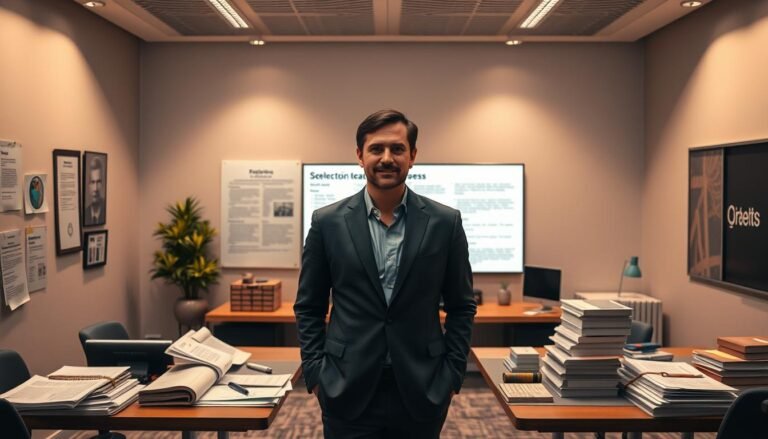Mastering Workplace Communication: Strategies for Effective Collaboration
Good communication at work is key to success. It helps teams work better together and be more creative and productive. Being able to talk well means sharing ideas easily, giving and taking feedback, and solving problems. When teams communicate clearly, they can tackle obstacles, meet their targets, and create a happy place to work.
This article will show you important techniques to get better at talking with your team. If you’re a leader, a manager, or a team member, these tips will help you speak up and be heard. They will also help make your team and company more successful.
Key Takeaways:
- Effective workplace communication is crucial for collaboration, innovation, and productivity.
- Strong communication skills enable sharing ideas, giving feedback, and resolving conflicts.
- Mastering workplace communication enhances team performance and contributes to a positive work environment.
- Implementing key strategies can improve communication and lead to better collaboration in the workplace.
- Stay tuned to discover practical strategies that will transform your workplace communication.
The Importance of Effective Workplace Communication
Today, rapid workplace changes make strong teamwork crucial. Good communication helps your team work well together. Teammates can share ideas, give feedback, and solve problems better.
Four out of every five workers say their company’s communication needs work. This means companies must invest in better talking and listening. Doing so can make teams more effective and boost the success of the entire company.
Effective communication is not just about exchanging information; it is about understanding and being understood.
Good communication lets people freely share their thoughts, sparking new ideas and creativity. This leads to solving challenges better and making smarter choices. As a result, the outcomes improve for everyone.
Also, clear feedback helps people grow by learning what they do well and what needs work. This kind of talk boosts both personal and team progress. It makes everyone more productive.
The Role of Collaboration
Teamwork and talking go hand in hand. When everyone communicates well, they can do more together. This helps blend everyone’s skills and wisdom for common goals.
Working together also softens the blow of conflicts. Open communication lets teams easily solve problems or misunderstandings. Tackling issues with talking often makes bonds stronger.
So, valuing clear communication and teamwork can greatly boost your company. This drives success by helping everyone fulfill their roles better and work together more effectively.
Now, let’s see some key ways to improve how teams communicate and reach their goals.
Strategies for Effective Communication
Effective workplace communication is key for teamwork. It helps build strong ties and solve problems. Organizations benefit from cultures that support good communication.
Active Listening and Empathy
Active listening means really paying attention when someone speaks. It shows you care and promotes trust. With empathy, understanding grows, making teamwork smoother.
Clarity and Conciseness
Clear communication prevents confusion and boosts teamwork. Using simple words and focusing on the main points helps. Everyone being on the same page means ideas are shared well.
Feedback and Constructive Criticism
Feedback is essential for growth, both at work and personally. It points out where to improve and how to get better. Offering feedback in a helpful way encourages progress.
“Feedback is the breakfast of champions.” – Ken Blanchard
Adaptability and Flexibility
Being adaptable makes communication better for everyone. It’s about tuning in to what others need. This creates a more welcoming environment for all.
Conflict Resolution Strategies
Conflict is normal, but how we tackle it matters. Listening openly and aiming for win-win solutions helps. With empathy, conflicts can be resolved, making the workplace better.
Continuous Improvement
Growing your communication skills is all about learning more. Taking feedback and learning from it keeps everyone sharp. Staying open to updates helps everyone do better at work.
By using these methods, workplaces can communicate better. This leads to more teamwork, better work, and everyone’s success.
The Role of Organizational Communication
Organizational communication is key to employee engagement and productivity. It’s vital for any business, letting employees share important info and ideas. It makes sure everyone is working towards the same goals, supporting the company’s vision.
A strong corporate communication plan ensures employees hear the right messages. It guides how to send messages that are clear and captivating. By using tools like emails and meetings, organizations show that they value open and honest communication.
It’s crucial to have one-to-one conversations at work. Talking directly with managers helps employees feel heard and supported. It opens up space for sharing thoughts and concerns. Encouraging two-way communication with feedback and open discussions lets employees shape the company’s future. This approach supports a culture of always getting better.
“Effective communication is key for success. It builds trust, engages employees, and lets them reach their full potential. With good communication, companies can encourage teamwork, new ideas, and hard work.”
Keeping messages consistent helps avoid confusion. When everyone hears the same things, they can act as a team. This makes work smoother and more efficient. Clear and direct communication helps everyone know what’s expected of them, leading to less stress and better teamwork.
The Power of Visual Communication
Using visual aids like charts and graphs is very powerful. They make complex info simple and easy to remember. Visuals grab people’s attention and help them grasp important information faster. They also work well for different types of learners.
Employees benefit from communication training. These programs help them become better presenters and listeners. They teach important skills for getting messages across well and understanding others. These sessions let employees practice and improve their communication skills in a positive setting.
“Strong communication skills help employees represent their company well. They make sure messages are clear and help build professional relationships.”
To sum up, organizational communication is crucial for employee engagement and productivity. A solid communication plan, along with personal talks and open feedback, builds a strong culture. Using visuals and training improves how well messages are understood. This all helps organizations run more smoothly and successfully.
Enhancing Communication Through Visual Aids and Training
Visual aids are key in making messages clear at work. With presentations and infographics, companies can communicate better. They help everyone learn by using pictures and charts.
This method is especially useful with complex ideas. Graphs and diagrams simplify hard concepts. Visual aids make talking about something easier and clearer.
Training for good communication is important too. It teaches people to speak clearly and to the point. Plus, it helps them think about others’ feelings, which is important for talking with empathy.
Listening well is taught in communication training. When people listen carefully and show they care, it makes a big difference. They learn to understand each other better and work together more effectively.
“Visual aids and communication training are powerful tools that improve work talk. They help everyone understand each other better and care more, which makes the team stronger.” – Laura Anderson, HR Manager
Talking with each other openly helps a lot as well. It creates a welcoming space for opinions and ideas. This leads to better work together and more innovation, all while making sure everyone’s voice is heard.
Diverse Learning Styles
Visual aids are great because they meet different learning needs. Some people learn best by seeing things, others by hearing or doing. Using pictures with words speaks to many different kinds of learners.
For those who learn visually, this is very effective. Seeing and reading together helps get the point across. It makes sure more people get what’s being said, which is really helpful.
Not to mention, visual aids also cross language and cultural barriers. They offer a way for people to understand no matter where they come from. This makes everyone feel included, which is very important.

Enhancing Training Programs
Training on how to talk well is crucial. It gives people the tools to speak clearly and interestingly. Adding pictures and diagrams to these trainings makes them better and more fun.
Using pictures in training not only helps people learn more but also makes them want to join in. They remember more when they take part. Such ways of teaching help them learn more deeply and get better at talking with others.
Improving Engagement and Collaboration
Visual aids and good training make for a more active, closer team. Giving people the right ways to communicate helps them join in and share. This makes working together more effective and enjoyable.
Using pictures in meetings keeps everyone’s attention. It makes talking about work more fun and draws people in. A culture where everyone speaks openly then takes hold, letting ideas flow more freely.
By talking openly and having these kinds of meetings, teams become stronger. They can share, learn, and solve problems together. This makes work not just better, but more successful too.
Creating a Positive Communication Culture
Creating a great place to work starts with clear and open communication. To build a strong team and boost productivity, a solid communication plan is key. This plan covers all talk inside and outside the organization.
Encouraging people to talk face to face is a powerful strategy. This invites team members to share their thoughts, give feedback, and get to know each other better. It deepens understanding and empathy within the team.
Using visuals like presentations and charts helps a lot. These materials make complex information easy to understand. They meet the varied learning styles of team members, helping everyone get the message.
Training for better communication is important too. Giving employees skills like listening well, presenting ideas clearly, and handling emotions helps everyone talk better. This boosts how well the team communicates as a whole.
Open talks and two-way communication are also crucial. Open sessions let employees speak up about their thoughts and concerns, making them feel heard. Two-way communication keeps info flowing, which is key for teamwork and solving problems together.
To wrap things up, creating a positive way of talking involves several steps. You start with a strong communication plan. Then you encourage team members to talk one-on-one and use visuals. Plus, you offer training, hold open sessions, and keep the talks flowing both ways. These methods help team communication and make the workplace more productive and united.
Conclusion
Learning to communicate well at work is key to thriving together and meeting goals. By using certain methods like listening well, being clear, giving good feedback, showing understanding, being flexible, solving problems together, and always getting better, businesses can make talking to each other easier and more positive.
Good communication at work makes employees more involved. This helps work go better and the whole team be more successful. When workers know they’re listened to, valued, and understood, they’re eager to do their best and help their team win together.
Putting effort into how we talk and building a culture of strong communication helps us face problems, end disagreements, and do better overall. Companies that focus on good communication not only work better together. They also create a space for great ideas, teamwork, and progress.







